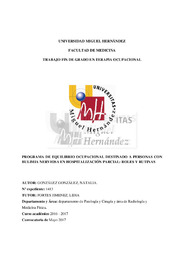Por favor, use este identificador para citar o enlazar este ítem:
https://hdl.handle.net/11000/26353Registro completo de metadatos
| Campo DC | Valor | Lengua/Idioma |
|---|---|---|
| dc.contributor.advisor | Fortes Jiménez, Lidia | - |
| dc.contributor.author | González González, Natalia | - |
| dc.contributor.other | Departamentos de la UMH::Patología y Cirugía | es_ES |
| dc.date.accessioned | 2022-03-25T07:39:52Z | - |
| dc.date.available | 2022-03-25T07:39:52Z | - |
| dc.date.created | 2017-05-09 | - |
| dc.identifier.uri | http://hdl.handle.net/11000/26353 | - |
| dc.description.abstract | El aumento de la incidencia y prevalencia de los trastornos de la conducta alimentaria, más concretamente la bulimia nerviosa, ha llevado a considerar dichos trastornos un problema de salud que debe ser abordado de forma multidisciplinar. La bulimia nerviosa se caracteriza por un desequilibrio ocupacional y una disfunción en sus rutinas y roles, destacando la necesidad de una intervención ocupacional desde el área de terapia ocupacional en los diferentes dispositivos asistenciales en función de la gravedad del trastorno. El objetivo de este trabajo es diseñar una propuesta de intervención desde terapia ocupacional con el fin de restaurar el equilibrio ocupacional, roles y rutinas de las personas con bulimia nerviosa entre quince y veinticinco años que se encuentren hospitalizados parcialmente en un servicio de sanidad publica español. La propuesta se basará en el Modelo de motivación al cambio (teoría motivacional) y el Modelo de Ocupación Humana. Tendrá una duración de catorce semanas. Las sesiones de evaluación del programa serán individuales, con el fin de conocer las diferentes alteraciones de la persona y la efectividad del proyecto, por otro lado, las sesiones de intervención serán grupales con talleres destinados a lograr diferentes objetivos. El programa ocupacional podrá aportar beneficios al participante en su bienestar físico, mental y emocional, así como en su calidad de vida, ayudando a la recuperación integral de la enfermedad. | es_ES |
| dc.description.abstract | The increase of the incidence and prevalence of eating disorders, more concretely bulimia nervosa, has led to consider such disorders a health problem that it must be approached in a multidisciplinary way. Bulimia nervosa is characterized by an occupational imbalance and a dysfunction in their routines and roles, emphasizing the need of an occupational intervention from the area of occupational therapy in the different care devices depending on the severity of the disorder. The main goal of this work is designing, from occupational therapy, a proposal of intervention with the aim to restore the occupational balance, roles and routines of those people who accomplish the next two condictions: they are between fifteen and twenty-five years old and they are partially hospitalized at the public Spanish health system. The intervention will be based on the next two models: Model of motivation to change (motivational theory) and the Model of Human Occupation. The intervention will last fourteen weeks. The intervention sessions will be group with workshops, in order to achieve different objectives. But, the evaluation sessions will be individual, in order to know, for each service users, his different alterations and the project effectiveness. The occupational program will improve service users quality of life by means of improving his physical, mental and emotional well-being, which at the same time, will help to the integral recovery of the disease. | es_ES |
| dc.format | application/pdf | es_ES |
| dc.format.extent | 45 | es_ES |
| dc.language.iso | spa | es_ES |
| dc.publisher | Universidad Miguel Hernández de Elche | es_ES |
| dc.rights | info:eu-repo/semantics/openAccess | es_ES |
| dc.rights.uri | http://creativecommons.org/licenses/by-nc-nd/4.0/ | * |
| dc.subject | bulimia nerviosa | es_ES |
| dc.subject | terapia ocupacional | es_ES |
| dc.subject | desequilibrio ocupacional | es_ES |
| dc.subject | roles y rutinas | es_ES |
| dc.subject.other | CDU::6 - Ciencias aplicadas | es_ES |
| dc.title | Programa de equilibrio ocupacional destinado a personas con bulimia nerviosa en hospitalización parcial: roles y rutinas | es_ES |
| dc.type | info:eu-repo/semantics/bachelorThesis | es_ES |

Ver/Abrir:
González González, Natalia.pdf
1,48 MB
Adobe PDF
Compartir:
 La licencia se describe como: Atribución-NonComercial-NoDerivada 4.0 Internacional.
La licencia se describe como: Atribución-NonComercial-NoDerivada 4.0 Internacional.
.png)